Nederlandse Modelbouw en Luchtvaartsite
Dutch Modelling and Aviation
Consolidated PBY-5/5A Catalina
Page 2 of 7
Period September 1941 till March 1942
May 1940 the delivery of long range patrol aircraft to the RNlNAS in Dutch East Indies, suddenly came to an end, when the Netherlands were overrun by the Germans. About one third of the ordered Dorniers Do-24 were delivered.
Because the allies already used the PBY and the RNlNAS was already interested in this type in 1937, it was an easy choice. After lot of negotiations an order for the delivery of 38 PBY-5 was made.
These aircraft received registrations Y-38 till Y-73.
After a short time a second order of another twelve aircraft, registered Y-74 t/m Y-85 was made. Because production had changed to the PBY-5A amphibian and this type was more useful, this order was changed in the delivery of twelve PBY-5As.
The first two flying boats, registered Y-38 and Y-39, were delivered on September 5, 1941. During the ferry Y-50 was damaged at Wake Island and repaired at the factory. During the attack of Pearl Harbour, on December 7, 1942, Y-68 was lost. Y-69, which was at Pearl Harbour, was confiscated by the US. It was returned to the Dutch in March 1942.
Because of the Japanese attack, another ferry route via Africa and Asia was necessary. Y-50 and Y-71 - Y-73 arrived via this route at Surabaya. Because of the critical circumstances at Singapore Y-52 till Y-54 were handed over to the RAF Singapore on October 15, 1941. They were detached at no. 205 squadron.

Consolidated PBY-5 flying over sea near Surabaya (note the small orange triangle on the fuselage)
[Enclosed photo from BeeldBank NIMH. Click on photo for ordering information]
[Enclosed photo from BeeldBank NIMH. Click on photo for ordering information]
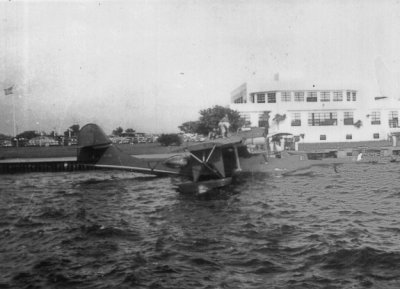
Consolidated PBY-5 Catalina in the original paint scheme
[Enclosed photo from BeeldBank NIMH. Click on photo for ordering information]
[Enclosed photo from BeeldBank NIMH. Click on photo for ordering information]

Consolidated PBY-5 Catalina (Y-38) (1941-1946) just arrived at Surabaya 1941
[Enclosed photo from BeeldBank NIMH. Click on photo for ordering information]
[Enclosed photo from BeeldBank NIMH. Click on photo for ordering information]

Consolidated PBY-5A Catalina (1941-1946) Y-38
[Enclosed photo from BeeldBank NIMH. Click on photo for ordering information]
[Enclosed photo from BeeldBank NIMH. Click on photo for ordering information]

Consolidated PBY-5 (Y-56) (1941-1946).
[Enclosed photo from BeeldBank NIMH. Click on photo for ordering information]
[Enclosed photo from BeeldBank NIMH. Click on photo for ordering information]

Consolidated PBY-5MN, Catalina 049, at the factory in the US. Text "Propeller hoist installed",
[Enclosed photo from BeeldBank NIMH. Click on photo for ordering information]
[Enclosed photo from BeeldBank NIMH. Click on photo for ordering information]
Losses
In the mean time several aircraft were lost:
- Y-38 sunk on February 9, 1942 during a rescue operation.
- Y-39 was used as training aircraft at Morokrembang and is possibly destroyed there by own military.
- Y-40 was shot down during a training flight on February 3, 1942.
- Y-41 was possibly lost in action.
- Y-42 was possibly lost in action.
- Y-43 was destroyed due to Japanese attacks.
- Y-44 crashed on December 5, 1941.
- Y-46 was damaged beyond repair during take off on October 7, 1941.
- Y-47 crashed in a landing in the night of February 22 to February 23, 1942.
- Y-48 was destroyed by own personnel on march 3, 1942.
- Y-50 was destroyed due to Japanese attacks.
- Y-51 was lost during a patrol mission on January 21, 1942.
- Y-58 was lost while bombing the Japanese fleet near Kema.
- Y-61 was destroyed due to Japanese attacks.
- Y-63 was shot down during a patrol flight on February 27, 1942.
- Y-65 was damaged on February 27, 1942 during an aerial fight.
- Y-66 caught fire due to Japanese attack on march 4, 1942.
- Y-72 was destroyed due to Japanese attacks.
Period after March 9, til VJ day
After the Dutch East Indies had surrendered on March 9, 1942, many crew escaped. Y-55, Y-56, Y-57 and Y-64 arrived at Koggala, Ceylon. Y-45, Y-59, Y-60, Y-67, Y-70 and Y-71 arrived in Australia. Due to the an expected attack of Broome on march 3, 1942 Y-59, Y-60, Y-67, Y-70 were lost.
Several personnel of RNlNAS managed to repair a PBY-4 of the US Navy. The unofficial serial P-3 was applied to the aircraft and flew to Australia. After an overhaul it was handed over to the RAAF. The aircraft, which arrived at Koggala were detached in no 222 group.
April 11, 1942 it was decided to form a Dutch navy squadron at Ceylon, equipped with the Catalina's. The five Catalina's in Australia were flown to Ceylon. By the end of may 1942 squadron 321 RAF was re-activated and detached at China Bay. The squadron stayed in no. 222 Group Coastal Command.
September 2,1942 PBY-5A Y-74 arrived as reinforcement. Soon the other eleven ordered PBY-5A's arrived. All these aircraft were equipped with radar.
Unfortunately Y-75 hit a rock and sunk. It could be rescued and repaired, but it was no longer useful for operational use. It was modified for transport of passengers and nicknamed Sky Sleeper.
Between October 11 and November 1, 1942 three PBY-5's, Y-69 being one of them were based at Mombassa [operation DemCat], Kenya because of the presence of a Japanese raider. Also because of the lack of radar equipped aircraft the patrols were of no use.
November 8, 1942 Y-71 was lost during a test flight, thus reducing the operational strength to just eight aircraft.
From December 15, 1942 four PBY-5A's were based at Ratmalana, Ceylon. besides the usual patrol flights the aircraft were used for special duties such as dropping or picking up espionage groups. Due to enemy submarine activities near Cape of Good Hope,
By the end of January 1943 6 PBY-5A's and 3 PBY-5's (Y-83; Y-85) were based at Darling, South Africa. The aircraft had English roundels and a small orange triangle applied. The amphibians were based at Darling and St.Albans (Det/Darling and Det/St.Albans; Det = Detachment); the flying boats were based at Durban (Det/Durban). April 8, 1943, Det/Durban was dismissed adn the boats returned to Ceylon.
By the end of May a storm damaged the camp of Det/Darling in such a way that they had to move to Brooklyn Air Station. September 19, 1943, Det/Brooklyn was dismissed and the aircraft were based on the isle of Socotra, Yemen. In October 1943 the aircraft of Det/St.Albans were also based at Socotra. December 30, 1944 Det/Socotra was dismissed.
Because of an engine failure Y-78/N was lost on December 9, 1943; Y-49/B was heavily damaged during a landing in the night by the end of December 1943. March 12, 1943 Y-45/A left for Australia (Det/Australia) to join the Do-24K, X-24. The aircraft had a large badge applied on the nose (Who can tell more about this??). The aircraft was mainly used for liaison duties for the Dutch intelligence services (NEFIS and NICA).
To replace the old Do-24K, X24, in June 1943 two new PBY-5's, Y-86 and Y-87 were added to Det/Australia. Y-86/U went soon, in July 1943, to Ceylon. Both aircraft had most probably a RAF camouflage pattern
August 25, 1943 Y-84/S was lost after a emergency landing because of lack of fuel.
April 23, 1944 again three Catalinas were based in South Africa, this time at Fasantekraal. In 1944 the old Y-55/C, Y-56/D and Y-64/G flying boats, which were already in use for training purposes, replaced with three PB2B1 Catalina IV's, registered Y-88/W, Y-89/X and Y-90/Y; August 1944 three other Catalina IV's were added, Y-91/Z, Y-92/B and Y-93/N. Al these aircraft were on loan from the RAF.
The aircraft were returned to the RAF in November and December 1944, when squadron 321 received their B-24 Liberators.
December 1945 Y-80 was withdrawn from use; Y-62, Det/Australia was lost because of an accident on October 13, 1945.
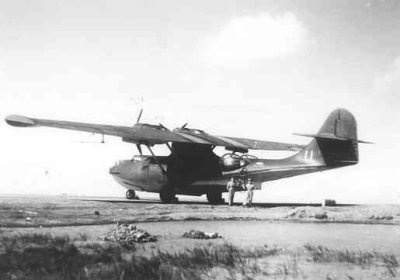
Consolidated PBY-5A Catalina (Y-74) ASV-antenna under the wing.
[Enclosed photo from BeeldBank NIMH. Click on photo for ordering information]
[Enclosed photo from BeeldBank NIMH. Click on photo for ordering information]

A Consolidated PBY-5A Catalina (1942-1953) in South Africa in 1943.
[Enclosed photo from BeeldBank NIMH. Click on photo for ordering information]
[Enclosed photo from BeeldBank NIMH. Click on photo for ordering information]

Consolidated PBY-5A Catalina Y-80 (1942-19523 at China Bay.
[Enclosed photo from BeeldBank NIMH. Click on photo for ordering information]
[Enclosed photo from BeeldBank NIMH. Click on photo for ordering information]

Consolidated PBY-5 Catalina (1941-1946), serial Y-83.
[Enclosed photo from BeeldBank NIMH. Click on photo for ordering information]
[Enclosed photo from BeeldBank NIMH. Click on photo for ordering information]

Consolidated PBY-5 Catalina Y-57 (1941) of detachment Australia autumn 1945.
[Enclosed photo from BeeldBank NIMH. Click on photo for ordering information]
[Enclosed photo from BeeldBank NIMH. Click on photo for ordering information]

Consolidated PBY-5 Catalina (1943-1946) flying over the sea near New Guinea.
[Enclosed photo from BeeldBank NIMH. Click on photo for ordering information]
[Enclosed photo from BeeldBank NIMH. Click on photo for ordering information]
Period after VJ day
By the end of 1945 again six PB2B1 Catalina IVb's were taken over from the RAF. These aircraft also received serials Y-88 til Y-93.
From half July 1946 all aircraft were re-registered with P-serials. Initially the P was written actually as "P"on the fuselage, from 1947 it was applied as "16".
During 1946 seven flying boats were added, two Catalina I, serials P-200 and P-204 and four Catalina IVa's, registered P-201, P-202, P-203, P-205 and P-206 Catalina IVa's. The aged P-57, P-69 and P-74 could now bet withdrawn from use.
Alas P-87, P-204 and P 93 were lost because of accidents.
By the end of 1946 four PB2B2 Catalina VI's were bought in Australia, these were registered P-207 till P-210. These flying boats differs from the other aircraft mainly because of their changed tail unit.
In 1947 squadron 321 squadron was abolished. The remaining Catalina's were grouped together with the bought Dakota's in OVTS (Oostelijk Verkennings en Transport Squadron = Eastern Reconnaissance ad Transport Squadron).
In September 1948 OVTS was split up in GVTA (= Groep Vliegtuigen A = Aircraft Group A), equipped with four flying boats and five amphibians and GVTB (=Groep Vliegtuigen B), equipped with three flying boats.
with the transfer of sovereignty to Indonesia the "Commando MLD in de Oost (= Easter Command RNlNAS) was dismissed. A new unit, squadron 7, was formed in New Guinea and equipped with P-76, P-77, P-85, P-202, P-203 and 205. During 1950 squadron 321 was reactivated again and also based in New Guinea White Catalinas P-200, P-75, P-79, P-82 and P-83
In 1951 six PBY-5A was bought in the USA and completely overhauled in the Netherlands. These aircraft entered serviced registered P-211 till P-216. P-212 and P-216 stayed in the Netherlands for SAR-purposes. P-203, P-205, P-202 and P-200 could now be withdrawn from use. In 1951/1952 the old and worn P-77, P-75 and P-76 were withdrawn form use and scrapped. P-79,P-83 and P-85 were re-registered as P-217, P-218 and P-219.
End 1953 in Australia six more EX-RAAF Catalinas were bought. These entered service with serials P-220 till P-225, P-223 was scraped because of spare parts. The other Catalinas were completely overhauled and entered operational service in the beginning of 1954.
In 1957 all remaining Catalinas were withdrawn from use. Catalina P-217 (ex P-79) was preserved as a monument at air base Biak. When New Guinea was annexed by Indonesia, this aircraft, together with a preserved Firefly IV, was sold to an Australian scrapyard.
P-212 was preserved and donated to a swimming pool in the Netherlands. In 1984 it was exchanged with a Hawker Hunter and is, after being completely overhauled and now on display at the Militaire Luchtvaart Museum (MLM = Military Aviation Museum at Soesterberg). Recently this aircraft was completely overhauled by Stichting Neptune Association.
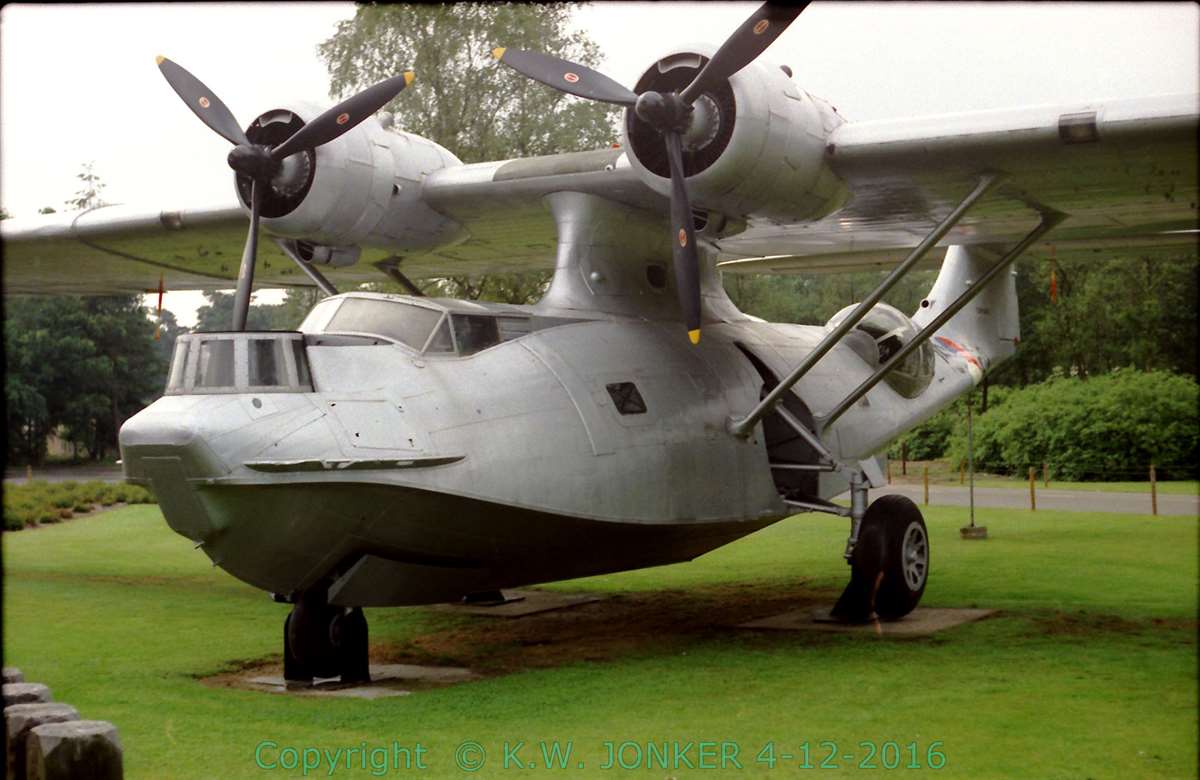
Catalina PBY-5A 212 photographed in 1985 at the Military Air force Museum at Soesterberg.
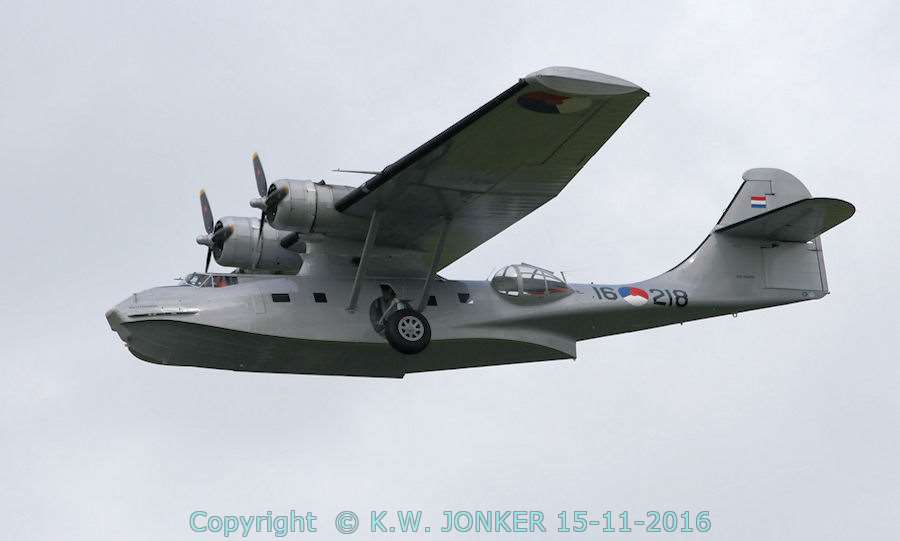
The Catalina PH-PBY of the Stichting Exploitatie Catalina PH-PBY.
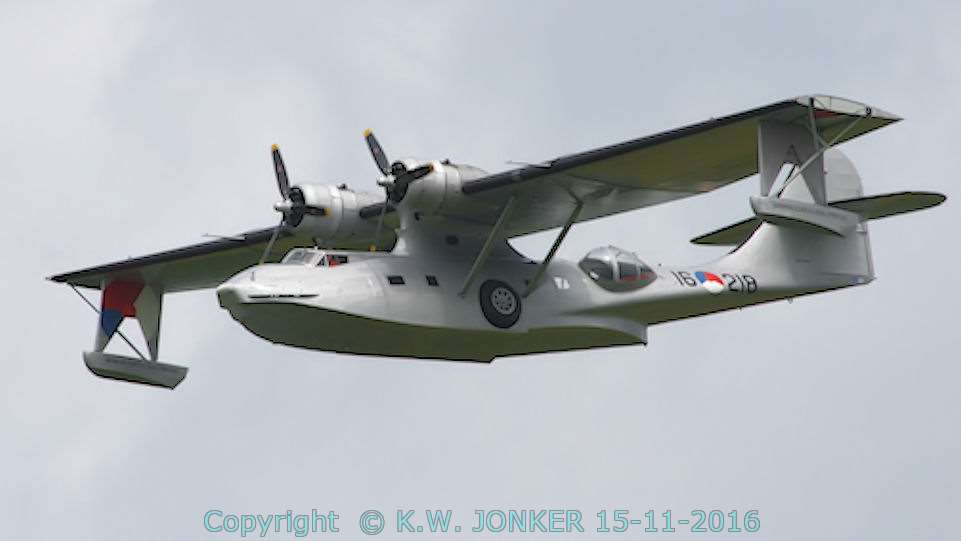
The Catalina PH-PBY of the Stichting Exploitatie Catalina PH-PBY.
